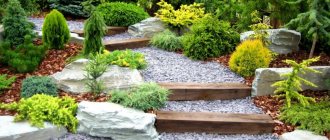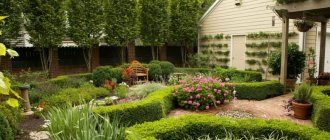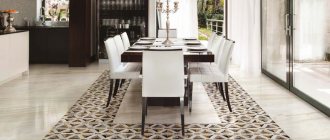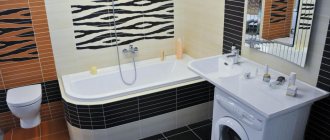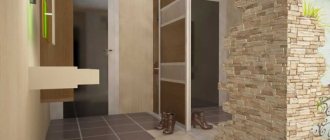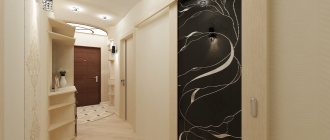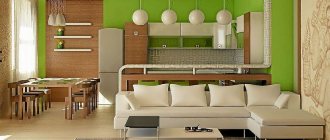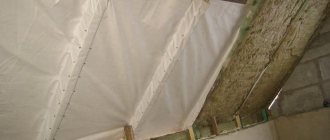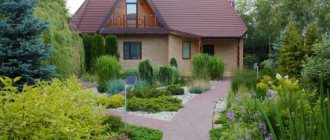True, many people are familiar with the situation when they want to decorate and diversify their garden plot, but it is not clear from which side to take up the matter. The phrase “landscape design” frightens with its complexity and scientific nature - and it seems that there is no way to cope with it at the dacha, there is not enough knowledge and skills.
But experts in their field can help you learn the basics of this very improvement of a dacha area, as well as decide where to start. We would like to introduce you to one of these. The following story is told on her behalf.
Ulyana Petrova, landscape architect at the Ginkgoland landscape design studio.
My name is Ulyana, I am a landscape architect. I don’t just landscape, but only with love. My personal secret to life’s work consists of:⠀
- higher education,
- experience "in the fields"
- love for business
- desire to improve the world around,
- needs to share.⠀
And as a result, I create dream gardens for you. And not only locally in St. Petersburg, but also informationally and visually on the Internet.
For your attention - several of my sketches - sketches of possible interesting garden compositions for different conditions and different areas. I simply recorded the idea and proposed the idea of its implementation in specific forms and cultures, and you might want to implement it on your own summer cottage - as they say, take it and do it!
Sketch No. 4
Shade-tolerant composition.⠀
Contains:
- Cross-paired microbiota
- Stefanandra incisifolia Crispa
- Rhododendron evergreen Cunningham's White
- Hosta hybrid
- White Derain Elegantissima
- Diabolo
- Viburnum common Roseum⠀
Important - it will take up a large area if you do not form plants. The area is calculated based on the maximum size of planted crops.
Don't forget about backfilling. Mulch will be good here, but make sure it fits into your garden concept.
↑ Territory elements
It is only possible to highlight the most characteristic zones:
- entry zone through which people and equipment enter the site (up to 7% of the entire territory);
- recreation area (no more than 15%);
- garden area (75%);
- management area: greenhouse, garage;
- children's play area.
It is convenient to connect certain zones together - space is saved and time is gained when moving.
Functional and aesthetic design ideally form one whole. Many individual parts merge into one composition. All details complement each other in size, color, and location relative to others. For example, a huge tree does not look very harmonious near a small house, and small flower beds do not fit well with a chic fountain.
The basic rule for the functional and beautiful arrangement of even a small area is the rejection of the desire for gigantomania. Excessively tall and voluminous buildings should be replaced with comfortable smaller buildings, if it is possible to build them. If not, existing buildings are alternated with areas for recreation, interspersed with flower beds and shrubs.
At the same time, too many plantings are also too much. It is important to find a compromise between “lots of greenery” and “enough greenery and it is beautiful.” When choosing the type of tree to plant, it is better to avoid species with an area root system. It is also better to refuse those that will be no less than home in years to come. It is optimal to plant fruit trees that are not too tall.
It is not recommended to build a blank high fence around the perimeter, which will make the area not cozy, but gloomy and cramped.
A balanced site necessarily includes natural greenery, a pond, paths and architectural elements (arches, sculptures). Creating them, placing them in the right place and obtaining a composition is the task of landscape design.
↑ Decorative plantings
One of the main elements of site design is the presence of shrubs, trees and greenery in a holistic composition. Each plant is planted separately or by creating an array of them. Separate flower beds and large flowerpots are fenced with shrubs, which will become a fence.
We recommend studying: the most beautiful varieties of ornamental trees for the garden
Topiaries (figures made from small bushes or trees that are trimmed to the desired shape) add their own style.
↑ Lawn
An element of the site that decorates the garden and at the same time creates it is the lawn.
The Moorish style is considered better than the others for the lawn. The style direction is a mixture of clearings and stripes of perennial and annual plants. They are restored every year by self-seeding. The piquancy is in the different flowering times of all plants: greens and colors play on the lawn throughout the summer.
Three key types of lawns are used when landscaping:
- sports: for areas where people often rest a lot (has high resistance to trampling);
- decorative: creates a background for surrounding objects (needs regular care);
- standard: made of uniform grass that fills the allocated space.
Grasses can be trimmed to any height.
↑ Reservoir
Any body of water is considered the highlight of the garden.
It is ideal when the territory is located on the shore of a natural body of water - a lake, river or pond. Your own pond is an opportunity to raise fish, water the future harvest, or just an element of beauty. The role of water is the basis for future design around the perimeter. The Japanese assign the leading role in terms of beauty to water. In other cases, water is considered an addition: for drinking, bathing, watering greens. Six reservoir options are used:
- water Mill;
- fountain;
- pool;
- waterfall or cascade;
- river;
- pond.
A swimming pool is considered optimal: it fits into any design, it is used for entertainment in the summer, and it perfectly houses a fountain.
↑ Fencing
The fence, as part of the landscape design, is selected to match the facade of the house. There are many options for its design: from a light net, simply showing the size of the area, to a protective brick wall braided with weaving plants. It is important to remember that even the most urban fencing can be enlivened, highlighted and decorated with it.
The basic purpose of a fence is to create security. But this is from the outside, and from the inside the fence is an integral part of the style of the site. From an aesthetic point of view, it is better to use brick, metal, wood and stone. In a rustic, Provencal or English style, it is recommended to decorate the fence with a liana, climbing plant or vine.
In any case, proximity to plants only improves the fence.
↑ Tracks
The shape, size and location of the paths make it possible to quickly and freely get to any place on the site, regardless of the weather. The path is considered an important part of the territory and is its divider when differentiated into zones.
Entrance paths (which connect the entrance to the site, the residential building and all structures), walking paths (auxiliary and for recreation) and those located between the beds are constructed.
Some types of tracks can be distinguished:
- by type of masonry: hard or soft;
- by location: not continuous and continuous;
- in width: main (1.5 meters) and walking (less than a meter);
- in shape: flat path or with a slope (for rainfall drainage, for example).
The distance between the individual components of the track is important: the smaller the better. Stone, brick, pebbles, gravel or tiles - each owner chooses according to his taste. The length and tortuosity directly depend on the size of the area.
In addition to the connecting function, the paths also carry an aesthetic load. Consequently, they complement the overall picture of the site. Therefore, a specific design color is selected, lighting poles are added to the side, or built-in lighting is installed for night walks.
↑ Flowerbeds
Regardless of the size of the plot and its design, it is best to install flower beds that will differ from each other in size, shape and content:
- summer permanent (with flowering throughout the summer);
- regular (the plants in it bloom strictly at a certain time of the year, they can be arranged in a pattern or even a pattern);
- vertical (placed on the wall);
- raised (one part of the flower bed is placed on a vertical structure).
↑ Flower garden
Unlike a flower bed (a strictly fenced area), a flower garden is an implicitly limited area where decorative greenery grows: from flowers to trees.
This is useful: growing Calla lilies in the garden - planting and care in open ground
The role of the flower garden is purely decorative. There are such types of flower gardens: vertical, mixed border and ridged.
Trees should not be too large. Low varieties are optimal for fruit trees, and decorative varieties for shrubs.
↑ Arbor
It is considered practically the main place for relaxation, especially in bad weather.
It is suitable for meetings with friends, family dinners, and private reading of books. Having a fundamentally simple design, it brings a lot of benefits. It can be built and decorated in hundreds of ways, but it is important to adhere to the overall design of the site. We save wisely: we’ll tell you how to make a summer gazebo with your own hands at the lowest cost
↑ Scenery
Sculptures, lighting, various objects and decorations - these can successfully emphasize any idea, color or structure. The country landscape pays a lot of attention to the scenery. Through such objects, the owner can express his character, and even his thinking.
In practice, everything that can be imagined is used, but more often than other elements, attention is paid to the following decorations:
- Lighting: the style of lamps or poles itself, individual lighting for plants (notable for highlighting the night beauty of nature and creating a mysterious atmosphere).
- Garden fireplaces: to create heating, it is mounted in a closed room or gazebo, and outdoors will be useful for the coziness of the general atmosphere, illumination of a certain area and cooking food.
Lighting also ensures safety in the area and creates a certain charm at night. It is important to plan and place it correctly.
Whether utilitarian or decorative, lighting creates a unique aura of a place - the play of shadows and light creates fabulous images and phantasmagoric outlines that can enhance the impression of ongoing conversations. If desired, you can focus on a bush, tree or sculpture, or illuminate the entire area.
- Figures and sculptures. Their shape, style, color design and size depend solely on the tastes of the owners - heroes of myths, works of art, unusual vases or classic gnomes with lanterns. For example, a mushroom family will hide the lack of grass, and a small chessboard will provide an opportunity to play.
- The slide will create a miniature mountain look, despite the overall labor intensity and richness of small details - this will only enhance the aesthetic side of the site.
- Ordinary or decorative stones, which have their own energy and are part of nature, can become an important part of the decor. Instead of throwing away the excavated stones, you can wash them with water from a hose, after which the designer will find a use for them as an element of the overall composition.
↑ Uneven terrain
Despite the difficulties in the relief, unevenness can become a key element of the entire design. A hill or depression is perfect as a center or a highlight that can be decorated. Irregularities can become a container for individual zones and serve as a pedestal for sculptures or plants.
Sketch No. 5
Light and spring “fragrant” sketch.
Contains:⠀
- Common lilac Charles Joly
- White Derain Elegantissima
- Spiraea japonica Little Princess
- Spiraea nipponensis Snowmound
This composition is perfect for the role of a screen if you need to cover an unsightly fence or outbuilding for the summer. Just remember to remove the lilac shoots in a timely manner.
In addition to its simple composition, the composition has another advantage - cost.
What to pay attention to
When choosing a company or private master in the field of landscape design, it is important to pay attention to a number of points:
- The main thing is special education. In order not to accidentally stumble upon a self-taught student posing as an experienced master, you must definitely study the documents that confirm the specialist’s experience. It is worth giving preference to professionals with specialized education who have acquired the knowledge of designers, architects and dendorologists.
- It is necessary to have a decent portfolio with design documents, sketches and photographs of finished objects. The contents of the portfolio will allow you to understand whether a specialist is suitable for you or not.
- Recommendations play an important role, as well as reviews from those who have used the services of professionals.
- Personal trust is also important. It is necessary that you feel sympathy for the designer. It’s good if he understands you perfectly. In this case, it will be possible to make the dream of a luxurious garden come true.
Studio website
If you are looking for professionals you can trust, we recommend contacting AM Agro. Company website Portfolio
We recommend that you familiarize yourself with the company's portfolio:
Sketch No. 7
A useful and interesting sketch “against green melancholy.”
This refers to dull, monochromatic thuja hedges, which can easily be “painted” with new colors and shapes.
Contains:⠀
- Norway maple Drummondii
- Common lilac Sensation
- White Derain Elegantissima
- Barberry Thunberg Red Rocket
- Spiraea japonica Golden Princess⠀
All the plants here are unpretentious and will not require much attention from you. You can get creative and add something of your own to this tree and shrub group.⠀
Legal points when choosing a landscape designer
Today, a landscape designer is a sought-after specialist. That is why there are many service offers in this area. In order not to make a mistake and choose a truly trustworthy professional, you need to take into account not only the specifics of this service. It is important to choose a landscape designer and have a clear idea of what needs to be done:
- When meeting the customer directly, the designer must provide examples of completed work. All important issues regarding the choice of architectural forms, zones, plants and style are also necessarily discussed. This is reflected in the created project.
- Before developing a project, a specialist must first inspect the site to assess its condition and capabilities. This is required to identify resources and objects, collect information about soil type and relief features. Geodetic measurements are carried out. All this is further reflected in the documents.
- When the site has been thoroughly studied, a project is developed. The designer is required to provide territory breakdown drawings and drawings. Other supporting documents are also required: estimates and work plans. At the same time, the cost of materials and services provided by specialists is prescribed.
- An experienced designer always gives a presentation of the created project. At the same time, comments and detailed explanations are made. He also discusses controversial issues with the customer and makes the necessary corrections to the project.
- When the project and schedule for the planned work are approved, strict control is mandatory at all stages. Reporting documentation is also required, which is provided when the order is completed.
Creating a landscape design is not easy. This is serious work, which is necessarily supported by documents. The designer is responsible for the strict implementation of all points specified in the project. All work is also guaranteed.
Sketch No. 8
This sketch can be used to “dilute” the hedge and design a viewpoint in the garden that will be one of the first to delight.
Contains:
- Common lilac on a trunk
- Cotoneaster brilliant
- Spiraea gray Grefsheim
- Mountain pine Benjamin
- Canadian spruce Conica
- Spiraea japonica Genpei
- Thuja occidentalis Globosa
- Cinquefoil Pink Queen
- Barberry Thunberg Bagatell
- Stefanandra incisifolia Crispa
This composition blooms in spring, early summer and even a little into July. This is the main “skeleton”; to complete the picture, do not forget about ground cover and perennials.
As you can see, the eyes are afraid - but the hands do. We will be glad if our heroine today and her ideas inspire you to create new beauty in your area.
What a landscape designer should know
A landscape designer is a specialist who designs personal plots, gardens and parks. He must, with the help of various elements of the natural landscape, all kinds of accessories and plants, hide existing shortcomings or make them advantages. At the same time, a truly harmonious and cozy atmosphere should be created.
A landscape designer must necessarily receive a specialized education. You also need imagination and good imagination. Such specialists are always creative individuals who prefer to transform the world around them.
It is worth choosing a landscape designer who should:
- Perform a landscape analysis of the territory.
- Develop landscape planning solutions.
- Create preliminary sketches for the project.
- Participate in the development of architectural elements.
- Implement landscape projects.
The specialist must be a true master who does not just create landscape design for the territory. He creates a harmonious space in which all elements are significant. Only experienced landscape designers can solve such a complex problem.
English
This direction is otherwise called landscape. The English-style landscape looks rich, homely and full, at the same time natural and slightly neglected. Everywhere there are thickets of flowering perennials, climbing roses and thick ivy, smooth curves of cobblestone garden paths, multi-tiered compositions of bright shrubs and trees.
The landscape almost always contains a small pond overgrown with reeds and ferns. Only it and the lawn grass will require regular care; otherwise, the English style is one of the most hassle-free.
Fifth tip
Don't neglect personal meetings. After all, creating a garden is a serious investment. Visit the offices of selected companies and talk with designers. After all, a landscape designer does not just design a garden, he creates the atmosphere of your site and home.
________________________________________________________________________
We hope that our advice will help you significantly reduce the time when searching for specialists and avoid disappointment from working with amateurs.
______________________________________________________________________
Mauritanian
Such a garden is a long-awaited oasis among the endless desert, the embodiment of luxury and bliss, an abode of rich colors, wondrous sounds and exotic aromas. It is isolated and hidden behind high walls, there is a swimming pool decorated with colorful mosaics, quinces, figs and peaches grow all around, and birds chirp on the branches. You can admire this beauty and absorb it while sitting on a low lounger.
The landscape in the Moorish style is formed according to the chor-bak principle, that is, “four squares” - this is the ancient heritage of Arab culture.
Taking into account the wishes of the client and the characteristics of the site
An initial inspection of the suburban area has been carried out, and the customer’s needs have been clarified. The next step is design. At this stage, difficulties may arise in working with the designer: he either insists on implementing exclusively his vision of the garden, or is completely focused on the client’s wishes. Both options lead to unfulfilled expectations. In the first case, the sketch will give aesthetic pleasure only to the designer. The second scenario threatens to implement a boring, trivial design with possible problems in the future.
How then to choose a specialist? Try to listen to his ideas impartially, as if you were an outside observer. If a designer explains his point of view, does not put pressure and tries to realize your desires, then you should listen to him. If you feel pressure, it is better to refuse further work.
I recommend: Features of choosing a fence design for an estate or dacha
No. 5. High-tech style
Modern high-tech style involves the embodiment of bold landscape fantasies. New materials , plants with unusual leaves, and original accessories are used There are no requirements for symmetry or asymmetry. This is a garden for busy people, as it requires minimal maintenance .
Main features:
- suitable for areas of any size and configuration;
- the predominance of modern materials, including polycarbonate, plastic, glass, metal , concrete and well-treated wood can be used. Colored and white gravel is suitable for paths. The color scheme includes silver, white, sand, light grey, green and blue, with red, yellow and orange accents;
- plants are placed in containers and vases of strict geometric shapes. Trees and bushes with clear crown shapes are used, for example, cypresses and pyramidal spruce trees, and boxwood and thuja trees are given strict geometric shapes with garden shears. A lawn and group plantings of tapeworms are welcome, but variegated flowers have no place here;
- Among the accessories , an important place is given to lamps; they should be modern, even slightly futuristic, in shape; colored landscape lighting, the use of LEDs and solar-powered lamps are encouraged. Contrasts are an important detail of style. You can decorate the area with abstract sculptures , balls and cubes made of metal and glass;
- reservoirs must be of original shape, framed with concrete or even metal.
Second tip
Another problem of the current market is designers who have received knowledge in this specialization as part of express training. These courses do not always provide the necessary knowledge to work in the landscape sector. Of course, there are frequent exceptions when a specialist has completed a 3-month course and at the same time independently studied more professional literature than in 5 years of university study.
It is difficult to assess the level of knowledge, but it is possible to understand the professional position. Feel free to ask about qualifications, professional diploma and educational institution. A good specialist will not be offended by such questions.
Creativity in action
To furnish a country house, it is not at all necessary to use exclusively expensive building materials, although in some cases they will be very appropriate.
The simplest elements, such as a homemade gazebo or a wicker fence, will add charm to the design of your site.
Actually, the latter’s technique is very useful when creating small fences for a flower garden, or other solutions.
Plaster sculptures, fakes made from plastic bottles, creating an artificial pond and other ideas can once again emphasize the uniqueness of the house and reveal the creative nature of the home owners.
Provencal
French provincial style breathes romance and antiquity. The heaviness of stone columns and cracked retaining walls is surprisingly combined with the grace of pergolas and trellises entwined with wild grapes. All colors are muted, garden furniture is covered with patina, a stream babbles somewhere, and the intoxicating aromas of olive and herbs are in the air.
Decorating a plot in the Provençal style is a difficult task: the necessary plants do not live in our latitudes, and it is even more difficult to recreate the architectural background. But it will be easy to keep an eye on such an estate, because there is some abandonment in its spirit.
Tyrolean
Setting up a little Switzerland is a good idea for owners of a small plot in a mountainous area with significant elevation changes and a heavily rugged landscape. If there are conifers and ground cover plants all around, that’s generally great. Mountains can be added by bringing more rubble and boulders of different shapes. With their help, it is not difficult to build an alpine slide or rock garden - the main element of this design trend.
A chalet-style country estate requires almost no maintenance. It should look as if it arose by itself, at the behest of nature, and its natural beauty was not touched by human hand.
We improve the recreation area
You can read a book, retire in silence, receive guests and much more in a specially designated area. A gazebo, terrace or even a pergola will come in handy for this. They all perform the same task and are located closer to home.
If a gazebo is installed and one of its sides is heavily ventilated, then it is better to make one wall blank, or, as an option, plant climbing plants.
Advantages of ready-made compositions
Ready-made modules are in great demand not only for landscaping city parks, squares and areas adjacent to public facilities, but also in the private sphere. Since such landscape compositions, ready-made solutions have a number of advantages.
- Large selection and clarity - specialized organizations offer an impressive range of plant arrangements in one style or another. There is no need to guess what the composition will look like in a few years; it is immediately clear how it fits into the overall image of the yard.
- Perfect harmony - you don’t have to rack your brains arranging certain types of trees, shrubs, flowers and herbs, everything has already been carefully thought out and selected. Each plant is combined with the others in shape, size, color scheme, and orientation in space, which is clearly demonstrated by examples of landscape compositions in catalogs and portfolios of organizations. Plus, all plants are zoned and grouped taking into account the climate zone and temperature and humidity requirements.
- Cost-effective – standard solutions developed in one design direction or another will cost less than individual design. It is enough to simply select a module or modules that are in harmony with the characteristics of the site and are represented by plants for which these characteristics are optimal (soil, groundwater level, solarity, wind rose).
You can admire the beautiful and stylish composition almost immediately after planting, since the groups use large-sized plants and specialized seedlings of flowers and herbs. Therefore, in most cases, landscape design implies the presence of ready-made modules.
